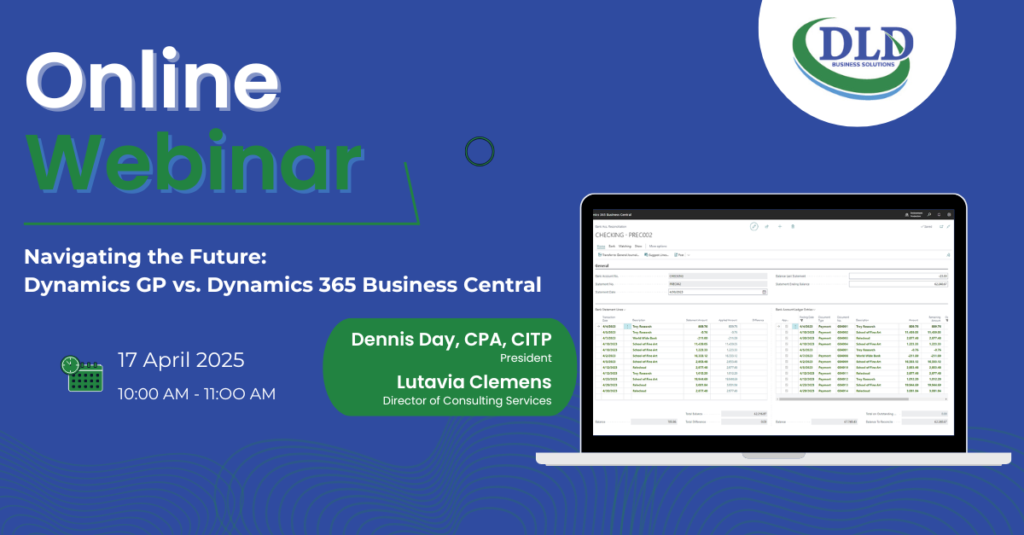Migrate from Dynamics GP with Confidence: Your Cloud ERP Game Plan
- April 1, 2025
- Posted by: DLD Business Solutions
- Category: Microsoft Dynamics GP

Few things in business are more frustrating than an unexpected IT crisis. And for many companies still using Microsoft Dynamics GP, that moment comes when a critical function breaks, leaving entire departments scrambling for workarounds while IT scrambles for answers. When systems start failing, businesses are left wondering: Is it time to migrate from Dynamics GP to a modern cloud solution?
That’s exactly what happened to a growing manufacturing firm when their finance team hit a major GP reporting failure at the worst possible time…month-end close. Invoices weren’t syncing, key reports wouldn’t generate, and hours of troubleshooting led to the same conclusion: their ERP system was becoming more of a liability than an asset.
Meanwhile, IT was buried under support tickets, patch updates, and security concerns, trying to keep an aging system running. The operations team was frustrated by outdated workflows, and remote employees struggled with access limitations and version control issues. It was clear that sticking with Dynamics GP was no longer sustainable.
The company needed a cloud-based solution that could eliminate these disruptions, provide real-time access to data, and reduce IT headaches. Migrating from Dynamics GP to Dynamics 365 Business Central was the logical next step, but to make the move smoothly, they needed a clear migration plan that ensured minimal downtime and maximum success.
Here’s how they did it – and how your business can, too.
Why Migrate from Dynamics GP to Business Central?
Let’s start with the obvious: Microsoft Dynamics GP has served thousands of businesses well over the years. But the reality is that technology has evolved, and so has Microsoft’s focus. Dynamics GP end of life is on the horizon, with official support for GP ending in 2029 and no major updates planned before then. As a result, businesses are being gently (or maybe not-so-gently) nudged toward the cloud.
That’s why migrating from Dynamics GP to Business Central is critical. It’s not just Microsoft’s future… it’s how your business gains long-term value.
Here’s why Business Central is the clear next step:
- Remote Accessibility: With Business Central, your team can access real-time data securely from any device, whether they’re in the office, at home, or anywhere in between.
- Scalability: As your business evolves, Business Central scales right along with you = no costly infrastructure or clunky upgrades needed.
- Automation: Manual, repetitive tasks (like approvals or data entry) can be automated, freeing your team to focus on more strategic work.
- Security and Compliance: Built on Microsoft’s trusted cloud infrastructure, Business Central includes strong access controls, encryption, and compliance features to protect your data.
- Cost Savings: By migrating from Dynamics GP to Dynamics Business Central, you’ll eliminate hardware costs, reduce IT maintenance, and gain automatic updates, without the budget surprises that often come with on-prem systems.
See Microsoft’s GP support timeline here.
It’s a big decision, I get it. So if you’re still weighing the pros and cons, we’ve broken it down even further in this post on moving from Dynamics GP to Business Central. Consider it your companion guide to making the “next right choice.”
6 Key Steps for a Smooth Dynamics GP to Dynamics 365 Migration
Every successful ERP migration begins with a plan (and no, “winging it” doesn’t count). These 6 steps are your roadmap for on-track transitioning:
- Assess Your Current System
Inventory your existing customizations, third-party integrations, and reporting needs. Doing so will help you determine what to migrate – and what to leave behind. - Define Your Migration Approach
The initial focus should be on transferring master records, open transactions, and essential historical general ledger data. DLD Business Solutions can help you plan the most efficient approach according to your needs. This is also the stage to decide whether a phased rollout or a full-scale deployment makes the most sense for your business, balancing continuity with the need for a smooth transition. - Clean and Prepare Data
This is the ideal time to do some digital housecleaning. But like moving houses, you don’t pack the junk drawer. Use this chance to clean out old data and give your system the clean start it’s been quietly begging for. - Choose the Right Tools & Partner
Microsoft gives you the toolbox, but unless you moonlight as an ERP contractor, you’ll want someone who’s done this before. DLD Business Solutions brings decades of experience to the table, helping businesses like yours migrate with confidence and minimal disruption. - Train & Onboard Your Team
Even the best software can flop if your people don’t know how to use it. Set up user training, create documentation, and make sure your team is ready to hit the ground running. - Test Before Going Live
This is typically the final step in a migration plan, but in DLD’s methodology, we recommend that it happens early on. We confirm key processes are addressed at the start of our engagement and ensure the entire implementation is planned around them. This also helps identify any processes that need to be addressed right away.
Migration Speed Bumps (and How to Avoid Them)
Even with the best-laid plans, there will be bumps in the road. Here are a few common ones – and how to navigate them:
Employee Resistance
Let’s face it: most people don’t like change. Ease the transition by involving end-users early, communicating benefits clearly, and providing support throughout the process.
Downtime & Disruptions
You can’t afford for your business to grind to a halt. Plan the go-live during a slower period, set realistic timelines, and keep your old system running in parallel during the transition if needed.
Third-Party Integrations
Custom integrations and legacy add-ons don’t always play nicely with cloud systems. Review compatibility ahead of time and work with vendors to update or replace as needed.
You’ve Made the Move! Now What?
Once you’re live in Business Central, it’s time to start reaping the rewards and setting your team up for long-term success.
Optimize Workflows – Take advantage of Business Central’s cloud-native features. Streamline manual processes, automate tasks, and simplify approvals.
Continuous Training & Support – Don’t stop supporting your team after go-live. Offer refreshers, answer questions, and encourage feedback to keep adoption strong.
Leverage Analytics & Automation – With real-time dashboards and built-in reporting tools, Business Central empowers better decision-making across your business.
Dynamics GP Had a Good Run, But Business Central is the Future
If you’ve relied on Dynamics GP for years, you made the right choice… for that time. But business moves fast, and the tools that once supported your success can become the very thing that holds you back. Microsoft Dynamics GP end-of-life may be the push you need to move your business forward.
If you’re still on the fence, take a look at our blog on moving from Dynamics GP to Business Central. It goes deeper into the reasons why more SMBs are making the move, and how DLD can help you do it right.
Ready to explore how Business Central can support your team? Contact DLD Business Solutions today to get started.

About the Author

Dennis L Day, CPA, is the President of DLD Business Solutions. He focuses on empowering businesses with intelligent, efficient solutions that drive success.
For over 23 years, we’ve been a trusted partner, delivering expert implementation, migration, and support services for Microsoft Dynamics ERP systems.
Whether you’re optimizing operations, boosting sales, or gaining valuable financial and operational insights, we’ve got you covered.
What sets us apart? We listen.
